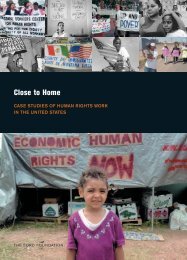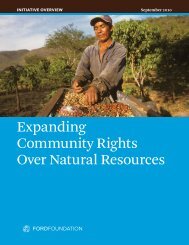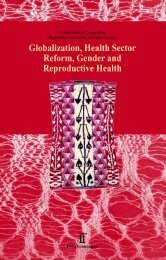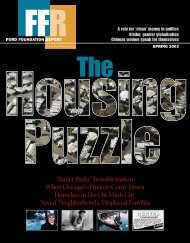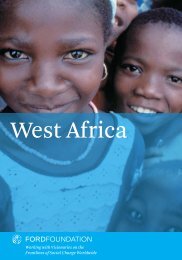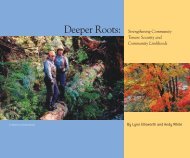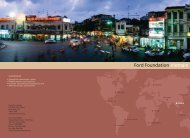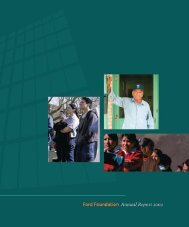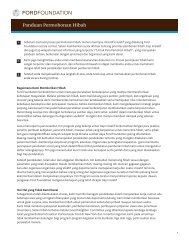Overcoming Barriers To Asset <strong>Building</strong>I have only one request.I do not ask for moneyAlthough I have need of it,I do not ask for meat…I have only one request,And all I ask isThat you removeThe road blockFrom my path.Okot p’Bitek“Song of an African Woman”Inequalities in the distribution of all types of assets are found in societies worldwide.While governments <strong>and</strong> multilateral agencies have long tracked income inequalitywithin <strong>and</strong> among nations, weak accounting systems <strong>and</strong> elusive data oftenconfound measurement on a global scale of even conventional assets, such as savings<strong>and</strong> equity. Nonetheless, the fact that approximately 25 percent of the world’s peoplereceive 75 percent x of the world’s income strongly suggests the precarious state ofthe assets base of the poor. In the United States, 10 percent of families control 90percent of financial wealth. xi It is estimated that without public sec<strong>to</strong>r safety nets,the assets of low-income households would cushion only three months’ hardshipcaused by sudden unemployment, a medical emergency, or other crisis. xii Of theworld’s 6 billion people, 2.8 billion, almost half, live on less than $2 a day. xiii Formuch of the world’s population, short-term crises <strong>and</strong> social disruptions, in theabsence of assets, imperil people’s very survival.When it comes <strong>to</strong> natural resources, the his<strong>to</strong>ric pattern worldwide is one ofincreasing corporate ownership <strong>and</strong> decreasing local community control.Residents of chronically poor areas are becoming more socially isolated; they havefew connections <strong>to</strong> mainstream society <strong>and</strong> little power <strong>to</strong> engage in decisionmaking.Low-income people, especially women, are disproportionately burdenedby reproductive health problems. The HIV epidemic increasingly reflects globalinequities in wealth, knowledge, <strong>and</strong> access <strong>to</strong> health care. In sum, the ‘haves’ areincreasing their control over assets while the ‘have-nots’ are fallingfurther behind.The pattern of asset distribution reflects his<strong>to</strong>rical <strong>and</strong> contemporary public policydecision-making <strong>and</strong> longst<strong>and</strong>ing cultural traditions. Today’s inequities are theresult of restrictive laws <strong>and</strong> barriers <strong>to</strong> education <strong>and</strong> services that exclude women,racial <strong>and</strong> ethnic minorities, <strong>and</strong> low-income people from creating, inheriting,purchasing, <strong>and</strong> in other ways building assets. An asset building approach seeks <strong>to</strong>change the ways assets are developed, distributed, <strong>and</strong> passed from generation <strong>to</strong>generation. This means confronting his<strong>to</strong>ric <strong>and</strong> contemporary forces of social,class, <strong>and</strong> caste exclusion, including racism, sexism, homophobia, <strong>and</strong> other formsof discrimination.
ASSETBUILDINGAT WORK:A Nest Egg For Nations And CulturesIn northwest Montana, the Blackfeet community is assembling philanthropic capital,preserving tribal culture, <strong>and</strong> broadening civic participation among both Natives <strong>and</strong>non-Natives through the efforts of the Blackfeet Community <strong>Foundation</strong> (BCF). Thedevelopment <strong>and</strong> growth of philanthropic capital as an asset has become a buildingblock of community well-being.The Native peoples of Montana make up nearly 7 percent of the population <strong>and</strong> live onseven reservations across the state. Over the last century <strong>and</strong> a half, they experienced theloss of their l<strong>and</strong> <strong>and</strong> natural resources <strong>and</strong> were confined <strong>to</strong> reservations with meagerresources <strong>and</strong> inadequate infrastructure. In addition, U.S. government education practices<strong>and</strong> policies eroded the Blackfeet language <strong>and</strong> cus<strong>to</strong>ms. Relations between white <strong>and</strong>Native communities were often distant <strong>and</strong> distrustful.For the last six years, as part of a strategy <strong>to</strong> build up its permanent philanthropic capitalas well as strengthen relationships between Natives <strong>and</strong> non-Natives in the region, theBCF has sponsored an annual Harvest Moon Ball <strong>and</strong> Indian Art Auction <strong>to</strong> raise funds,provide a community gathering place, <strong>and</strong> highlight the work of renowned Indian artists.Proceeds from the event are invested in an endowment fund now <strong>to</strong>taling over $210,000,that generates income <strong>to</strong> support community-building activities on the BlackfeetReservation. As the endowment fund grows, it bolsters the Blackfeet community’saspirations for greater independence <strong>and</strong> opportunity.In the meantime, the Montana Community <strong>Foundation</strong> (MCF), of which the Blackfeet<strong>Foundation</strong> is an affiliate, has exp<strong>and</strong>ed its support for reservation-based nonprofits<strong>and</strong> tribal enterprises, including the Piegan Institute, a language preservation school,the Blackfeet pencil company, the Blackfeet Reservation Development Fund’s financialeducation <strong>and</strong> mini-bank program, an Individual Development Account program,<strong>and</strong> a recycling business that employs 14 disabled youth <strong>and</strong> has inspired communitybeautification efforts. Developing philanthropic capital as a community asset is havinga powerful impact, says former MCF board chair, Sue Talbot.“Things happen. There arenatural disasters, <strong>and</strong> man-made ones. But if communities have organized themselves<strong>and</strong> built their capacity, they’ll weather those changes better. And if they’ve saved bybuilding an endowment, they’re even more able <strong>to</strong> bounce back.”The Blackfeet Community <strong>Foundation</strong> emerged as part of an effort <strong>to</strong> strengthenthe Montana Community <strong>Foundation</strong> <strong>and</strong> other statewide <strong>and</strong> regional communityfoundations. Since 1993, the initiative has helped MCF <strong>to</strong> increase its permanent assetsfrom $4.5 <strong>to</strong> $35 million, boost grantmaking, diversify its donor base, <strong>and</strong> increase itscapacity <strong>to</strong> attract new resources. MCF also helped establish the Blackfeet Community<strong>Foundation</strong> as an affiliate <strong>to</strong> provide a new vehicle for building the assets of the Nativecommunity. As MCF board member <strong>and</strong> Blackfeet leader Elouise Cobell notes, “TheBCF built on 25 years of organizing <strong>and</strong> community development by tribal leaderswho in many different ways have been working <strong>to</strong> reclaim Native assets—especiallyl<strong>and</strong> <strong>and</strong> trust funds—<strong>and</strong> <strong>to</strong> build other assets in an effort <strong>to</strong> secure the sovereigntyof the Blackfeet nation, the vitality of its culture, <strong>and</strong> economic opportunities available<strong>to</strong> its people.”Since 1993 the <strong>Ford</strong> <strong>Foundation</strong> has supported MCF <strong>and</strong> seven other community foundationswhen it launched the Rural Development <strong>and</strong> Community <strong>Foundation</strong> Initiative(RDCFI). The RDCFI has helped MCF <strong>and</strong> others increase their ability <strong>to</strong> raise capital, includerural residents in decision-making, <strong>and</strong> engage in grantmaking that draws from national bestpractices while being locally responsive.





